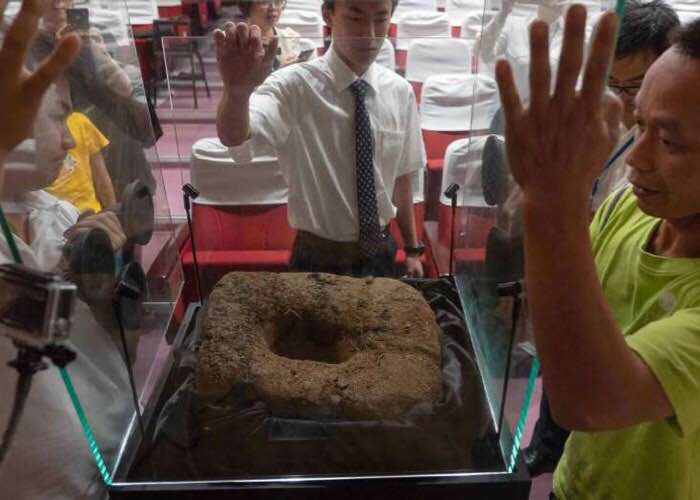


Workers prepare a meteorite crater for display at the Shanghai Natural History Museum on Saturday. [Gao Erqiang/China Daily]
A meteorite crater in Yunnan province has been recovered and collected by the Shanghai Science and Technology Museum on August 18, marking the first time that a Chinese museum has acquired such a crater.
The museum made the announcement during a news conference in Shanghai on Saturday, presenting both the impact crater and two meteorite falls.
The meteorite made landfall in Mangui village in suburban Jinghong city, Xishuangbanna Dai autonomous prefecture of China’s southwestern Yunnan at 21:45 on June 1.
The incident was witnessed by many locals and videos capturing the fireball falling from sky were circulated online.
Xu Weibiao, an astronomer at the Chinese Academy of Sciences who studied the incident, said more than 500 pieces of meteorites weighing a combined 50 kilograms were scattered across a narrow area measuring 20 square kilometers.
The meteorites are classified as type L6 ordinary chondrites, one of the common groups of meteorites, he said.
The 13-centimeter-long, 25-centimeter-wide crater the museum acquired at N22° 2’ 6”, E100° 10’ 29” was created by the meteorite’s largest mass, named Mangui 1, weighing 1,228 grams.
“Although the meteorite is not a rare type, but a complete information chain — the witness videos, the main meteorite and its crater formed — is of great value for researchers,” Xu added.
The Mangui 1 was founded by villager Yu Xianghuai in her tea garden on June 7, and bought by Shanghai meteorite hunter Zhang Bo.
“I was among the first from outside the village who had arrived at scene, but hundreds of local people were already there searching for meteorites in the field,” said Zhang, who arrived in Xishangbanna on June 3 and started hunting for meteorite falls.
Zhang did not reveal the price he paid Yu for the meteorite, but he said he would loan the stone to the Shanghai Science and Technology Museum as part of an exhibition in its new planetarium. Located in Pudong New Area, the planetarium, which covers an area of 38,000 square meters, is set to be the world’s largest when it opens to the public in 2020.
As Zhang discovered the crater had not been destroyed, he contacted the museum immediately.
Lin Qin, deputy chief of the astronomical department of the museum, said when the museum’s administrators learned about the news, they promptly agreed to recover the crater.
After negotiations, Yu agreed to donate the crater to the museum for public display.
“The size of the crater and the fact that it remained intact make it ideal for retrieval,” Lin said. “As far as I know, there are no other museums in the world with such an exhibit.”
The museum dispatched a crew to Xishuangbanna and transported the crater back to Shanghai on Aug 16.

 Award-winning photos show poverty reduction achievements in NE China's Jilin province
Award-winning photos show poverty reduction achievements in NE China's Jilin province People dance to greet advent of New Year in Ameiqituo Town, Guizhou
People dance to greet advent of New Year in Ameiqituo Town, Guizhou Fire brigade in Shanghai holds group wedding
Fire brigade in Shanghai holds group wedding Tourists enjoy ice sculptures in Datan Town, north China
Tourists enjoy ice sculptures in Datan Town, north China Sunset scenery of Dayan Pagoda in Xi'an
Sunset scenery of Dayan Pagoda in Xi'an Tourists have fun at scenic spot in Nanlong Town, NW China
Tourists have fun at scenic spot in Nanlong Town, NW China Harbin attracts tourists by making best use of ice in winter
Harbin attracts tourists by making best use of ice in winter In pics: FIS Alpine Ski Women's World Cup Slalom
In pics: FIS Alpine Ski Women's World Cup Slalom Black-necked cranes rest at reservoir in Lhunzhub County, Lhasa
Black-necked cranes rest at reservoir in Lhunzhub County, Lhasa China's FAST telescope will be available to foreign scientists in April
China's FAST telescope will be available to foreign scientists in April